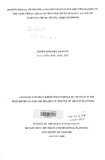| dc.description.abstract | Planning for peri-urban areas has always posed many problems such as loss of agricultural
land, lack of control, inadequate facilities, development pressures, lack of adequate data for land
use changes, conflicting land tenure systems and institutional weaknesses. Planners and
policy makers have responded to these problems with a variety of regulatory approaches,
institutional arrangements and policies with little success. The study critically examined the roles
of various institutions involved in land use planning and management in the study area and
the statutory structure for their operations and their performance. Lack of a clear institutional
framework for land use planning and management has led to haphazard development in the periurban
areas as these areas experience rapid urbanization.
The institutional problems and constraints in land utilization in the study area manifest
themselves in the form of un procedural conversion of freehold land into urban uses, illegal
invasion and subdivision of private land, informal subdivision of un controlled land, the
emergence of informal settlements, inadequate provision of infrastructural facilities such as
sewage and solid waste disposal systems and environmental degradation. The study has
established that the land use planning and management institutions are faced with a number of
problems such as lack of enough skilled manpower, equipments, resources, lack of
organizational eoordination, lack of a local physical development plan to guide and
coordinate land use activities, fragmented land laws, conflicting jurisdictional powers and
lack of local community's involvement in the planning and management process. The present
institutional arrangements in the area have problems of coordination and functional definition.
Therefore, the research recommended the need to establish clear roles of each of the institutions
involved in land planning and management in the area.
Further, the study recommended that there was need to coordinate all the planning institutions
in the study ~ea uncWr one umbrella peri-urban body that would oversee and coordinate all
land use planning and management activities both in the Namanga Road -Stony Athi corridor and
other peri-urban areas of our cities and urban centres. This will involve devolving planning powers
fully to the Local Authorities and equipping them with adequate skilled professional personnel. The
study also recommended that human resource development, establishment of an integrated land
management database and community participation in development control enforcement
would be key to effective utilization and management of land resources in peri-urban areas for
sustainable development. | en |

